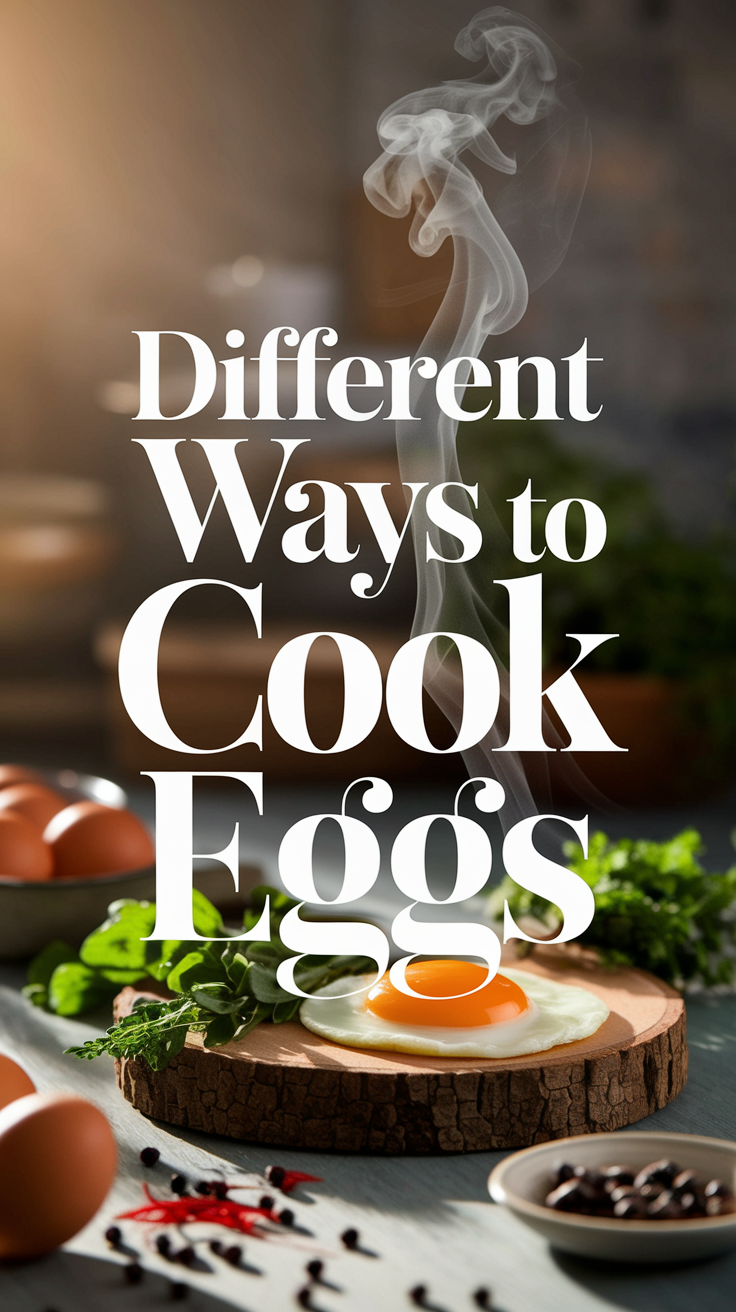Eggs are one of the most versatile and nutritious foods available. They can be prepared in various ways, each offering unique flavors and textures. Let’s explore some popular techniques for cooking eggs that you can easily try at home.
Boiling Eggs
Boiling is one of the simplest methods. You can make soft-boiled or hard-boiled eggs depending on your preference. Here’s how to do it:
- Soft-Boiled: Place eggs in a pot of boiling water for about 6-7 minutes. Remove them and cool them in ice water to stop the cooking process.
- Hard-Boiled: Boil eggs for 9-12 minutes for a fully cooked yolk. Cool them afterward for easy peeling.
Frying Eggs
Frying eggs can be done in several ways, giving you options for how firm or runny you like your yolks.
- Sunny-Side Up: Crack an egg into a hot skillet without flipping it. Cook until the white is set but the yolk remains runny.
- Over-Easy: Cook the egg sunny-side up, then gently flip and cook for another minute for a slightly runny yolk.
- Over-Hard: Flip the sunny-side-up egg and cook until the yolk is fully set.
Scrambling Eggs
Scrambled eggs are perfect for a quick breakfast. Here’s an easy method:
- Whisk eggs with a pinch of salt and pepper in a bowl.
- Heat a non-stick skillet over medium heat and add some butter.
- Pour in the eggs and stir gently with a spatula until they begin to set. Remove from heat to prevent overcooking.
Baking Eggs
Baking is a great technique when you want to serve multiple people. You can bake eggs in muffin tins or casseroles. Here’s a simple idea:
- Egg Muffins: Beat eggs with your choice of veggies, cheese, and meat. Pour the mixture into greased muffin tins and bake at 350°F (175°C) for about 20 minutes.
Poaching Eggs
Poaching is a delicate way of cooking eggs that yields a soft, tender texture. To poach an egg:
- Bring a pot of water to a gentle simmer and add a splash of vinegar.
- Crack an egg into a small bowl and gently slide it into the simmering water.
- Cook for 3-4 minutes until the white is firm but the yolk remains soft. Remove with a slotted spoon.
Cooking Eggs in Other Styles
Explore some additional styles that elevate your egg dishes:
- Omelet: Whisk eggs and pour into a hot skillet. Add fillings like cheese, vegetables, or meats, then fold.
- Shakshuka: Poach eggs in a spicy tomato sauce. This Middle Eastern dish is packed with flavor.
- Cloud Eggs: Whip egg whites until fluffy, mound them on a baking sheet, and bake. Then add the yolk and bake a little longer.
Tips for Perfect Eggs
Here are some helpful tips to ensure you get the best results when cooking eggs:
- Always use fresh eggs for the best flavor and texture.
- Keep the cooking temperature low to avoid tough or rubbery eggs.
- Season eggs before cooking for enhanced flavor.
Whether you prefer them soft or hard, scrambled or poached, trying out these different ways to cook eggs not only adds variety to your meals but also allows you to discover your favorite egg style. For more tips and recipes, visit Eggs.ca and explore the delicious world of eggs.
The Health Benefits of Eggs: Nutrition and Beyond
Eggs are a versatile food that pack a powerful nutritional punch. They are not only delicious but also packed with essential nutrients that can bring numerous health benefits. Eating eggs regularly can contribute to your overall well-being in various ways.
Rich Source of Nutrients
Eggs are often called a “complete protein” because they contain all the essential amino acids your body needs. A large egg has about:
- 6 grams of protein
- Vitamin D (to support bone health)
- Vitamin B12 (important for nerve function)
- Choline (for brain health)
- Omega-3 fatty acids (heart health)
Boosting Eye Health
Consuming eggs can also play a role in maintaining good eyesight. They contain lutein and zeaxanthin, two antioxidants that can help prevent age-related macular degeneration and cataracts. These carotenoids are more effectively absorbed by your body when consumed with the fat found in egg yolks.
Helping with Weight Management
Including eggs in your diet can keep you feeling fuller for longer. This may help in controlling appetite, which is essential for maintaining or losing weight. Research shows that eating eggs for breakfast can lead to a lower calorie intake throughout the day. Making them a regular part of your meals can promote a healthier eating pattern.
Supporting Brain Function
Choline, found in eggs, is crucial for brain health and proper cognitive function. It plays a significant role in producing neurotransmitters, which help in mood regulation, memory, and overall mental function. A diet rich in choline can also support brain development in infants during pregnancy and early childhood.
Improving Heart Health
Recent studies indicate that eggs can boost heart health. They help raise HDL (high-density lipoprotein), known as the “good” cholesterol. While eggs contain cholesterol, they don’t appear to raise blood cholesterol levels in most people. The key is consuming them in moderation and as part of a balanced diet.
Easy to Prepare in a Variety of Ways
One of the greatest benefits of eggs is their versatility. There are countless ways to prepare them, making it easy to include them in your diet. Here are some different methods:
- Boiled
- Scrambled
- Poached
- Fried
- Baked (shakshuka, frittatas)
Gut Health Benefits
Eating eggs can positively impact gut health. They are a good source of probiotics when prepared as part of fermented dishes. Probiotics promote a healthy balance of gut bacteria, which is essential for digestion, as well as immune system support.
Enhancing Skin and Hair Health
The nutrients found in eggs do wonders for skin and hair. The high protein content helps in repairing cells, while vitamins like A, D, and E promote healthy skin and hair growth. Regular consumption of eggs can lead to a radiant complexion and shiny hair.
When to Consider Moderation
While eggs are nutritious, it’s crucial to consume them in moderation, especially for those with specific health concerns. Individuals with cholesterol-related issues should consult their healthcare provider to establish a suitable intake level. A balanced diet incorporating a variety of foods is always recommended for optimal health.
| Type of Egg Preparation | Calories | Protein (grams) | Fat (grams) |
|---|---|---|---|
| Boiled | 77 | 6.3 | 5.3 |
| Scrambled | 91 | 6.7 | 7.0 |
| Fried | 90 | 6.5 | 7.0 |
Incorporating eggs into your diet provides numerous health benefits that can enhance your physical and mental well-being. Whether you’re looking to improve eye health, support brain function, or manage weight, eggs can be an asset in your healthy eating plan. For more information on the nutritional benefits of eggs, you can visit Healthline or explore Egg Nutrition Center.
Creative Egg Dishes from Around the World
Eggs are a universal food that appears in countless culinary traditions around the globe. The versatility of eggs allows them to be transformed into a wide array of creative dishes, reflecting the local culture and flavors of each region. Below are some delicious egg dishes from various countries that showcase the creative ways people enjoy this humble ingredient.
Shakshuka
Originating from North Africa and popularized in the Middle East, shakshuka is a hearty dish made from poached eggs in a spicy tomato sauce. The sauce usually includes ingredients like bell peppers, onions, and various spices such as cumin and paprika. It’s often served with crusty bread to soak up the delicious sauce.
Spanish Tortilla
This traditional Spanish dish, also known as tortilla española, features eggs cooked with potatoes and onions. The mixture is sautéed until tender and then combined with beaten eggs, creating a thick, flavorful omelet that can be served hot or cold. Enjoy it as a tapa or main course.
Bibimbap
From Korea, bibimbap translates to “mixed rice” and is often topped with a fried egg. The dish includes an array of vegetables, marinated meat, and gochujang (Korean chili paste) for flavor. The runny yolk from the egg adds richness and ties all ingredients together when mixed.
Huevos Rancheros
A classic Mexican breakfast, huevos rancheros features fried eggs served on corn tortillas topped with a zesty tomato and chili sauce. Beans, avocado, and sour cream are commonly added for extra flavor and texture, making it a hearty and satisfying meal.
Menemen
Menemen is a Turkish dish consisting of scrambled eggs mixed with tomatoes, green peppers, and spices. The ingredients are sautéed until soft, and then the eggs are mixed in, creating a dish that is often enjoyed with crusty bread. It’s a common breakfast choice in Turkey.
Oeufs Cocotte
This French dish, also known as baked eggs, is made by placing eggs in small ramekins with cream and other ingredients, often including herbs, cheese, or vegetables. The ramekins are baked in a water bath until the eggs are just set. It’s an elegant dish perfect for brunch or a light dinner.
Egg Curry
In India, egg curry is a popular comfort food. Boiled eggs are cooked in a rich and spicy gravy made with tomatoes, onions, and a variety of spices like turmeric, coriander, and garam masala. This dish is best served with rice or naan for a satisfying meal.
Sunnyside Up with Pesto
This easy yet inventive dish combines the classic sunnyside-up egg with fresh pesto. The bright green flavor of the basil pesto complements the richness of the egg yolk perfectly. Serve it on toast or alongside roasted vegetables for a simple yet tasty meal.
With so many unique ways to prepare eggs, the only limit is your imagination. Try some of these globally inspired dishes to experience the creativity and variety that eggs can offer. Here are some additional places to explore and get recipes:
Experimenting with different dishes can open up a world of flavors and textures, making eggs a delightful part of any meal. Whether you prefer them spicy, savory, or even sweet, there’s an egg dish to cater to your taste buds from cultures around the world.
Perfecting Your Eggs: Common Mistakes and Solutions
Cooking eggs can be an art form, but even the best chefs can make common mistakes. Whether you’re scrambling, boiling, or frying, understanding these missteps—and how to correct them—means the difference between a perfect egg and a mediocre one.
Overcooking Scrambled Eggs
One of the most frequent issues with scrambled eggs is overcooking. When you cook them too long, they become dry and rubbery. To avoid this:
- Cook on low heat, allowing the eggs to gently thicken.
- Remove them from the heat while they’re still slightly undercooked. The residual heat will finish cooking them.
- Add a splash of milk or cream before cooking for creaminess.
Inconsistent Boiled Eggs
If you prefer boiled eggs, you might struggle with achieving the perfect yolk. Too soft or too hard can vary greatly. Follow this simple method:
- Place eggs in a saucepan and cover with cold water.
- Bring to a boil, then cover and turn off heat. Let them sit for:
- Soft-boiled: 4-5 minutes
- Medium-boiled: 6-8 minutes
- Hard-boiled: 9-12 minutes
- Cool in ice water to stop the cooking process.
Poorly Fried Eggs
Fried eggs can be tricky. Often, they stick to the pan or the yolk breaks. Here’s how to fry perfect eggs:
- Use a non-stick skillet and preheat it over medium heat.
- Add a little butter or oil and wait until it sizzles.
- Crack the eggs gently to keep the yolks intact and fry until the whites are set.
Incorrect Temperature for Poached Eggs
Poaching eggs can cause frustration. If the water is too hot, it makes the eggs tough and if it’s too cool, they won’t set correctly. To poach eggs perfectly:
- Bring water to a gentle simmer (not boiling), adding a splash of vinegar to help the egg white firm up.
- Crack the egg into a small dish before gently sliding it into the water.
- Cook for about 3-4 minutes for a soft runny yolk.
Neglecting Seasoning
Seasoning is paramount to enhancing the flavor of your eggs. Here are quick tips:
- Add salt and pepper right before cooking for even distribution.
- Experiment with herbs like chives, parsley, or dill.
- For a twist, incorporate spices like paprika, turmeric, or cumin.
Saving Space for Cooking Techniques
| Cooking Method | Common Mistakes | Solutions |
|---|---|---|
| Scrambled | Overcooking | Cook on low heat, remove slightly undercooked. |
| Boiled | Inconsistent yolk | Follow time for desired doneness. |
| Fried | Sticky eggs | Use a non-stick skillet, preheat oil/butter. |
| Poached | Wrong water temperature | Gentle simmer, add vinegar. |
By paying attention to these common mistakes and their solutions, you can perfect your eggs every time. Cooking is not just about following a recipe; it’s about understanding the techniques and how they affect your results. For more tips on mastering egg cooking, you can visit Egg Farmers of Canada or AllRecipes Egg Dishes.
With practice and attention to detail, you’ll find that perfecting your eggs can become easy and enjoyable. Engage with the process, and you will love the delicious results on your plate!
Egg Cooking Methods for Every Meal: Breakfast to Dinner
Eggs are a versatile ingredient that can enhance any meal of the day. From breakfast to dinner, there are countless ways to cook eggs. Understanding different methods can help you unleash your culinary creativity and enjoy a variety of flavors and textures. Here are some popular egg cooking methods to inspire your next meal.
Boiled Eggs
Boiling is one of the simplest ways to cook eggs. You can tailor the doneness according to your preference. Here are the common types of boiled eggs:
- Soft-Boiled: Cook for about 4-6 minutes. The whites will be set, but the yolk will remain runny.
- Medium-Boiled: Cook for about 7-9 minutes. The yolk becomes creamy, yet slightly firm.
- Hard-Boiled: Cook for 10-12 minutes for a fully set yolk. Great for salads or as a snack.
Tip: To easily peel hard-boiled eggs, use eggs that are a few days old and cool them in ice water immediately after boiling.
Scrambled Eggs
Scrambled eggs are a breakfast staple. To achieve fluffy scrambled eggs, follow these steps:
- Crack the eggs into a bowl and whisk them with a pinch of salt.
- Heat a non-stick skillet over medium heat and add a bit of butter or oil.
- Pour in the eggs and stir gently with a spatula, cooking until just set.
You can add ingredients like cheese, green onions, or tomatoes to enhance the flavor.
Fried Eggs
Fried eggs can be cooked sunny side up, over-easy, over-medium, or over-hard. Here’s how to do it:
- Sunny Side Up: Cook on low heat until the whites are set, but the yolks remain runny.
- Over-Easy: Cook the first side, then flip gently and cook for another minute for a slightly runny yolk.
- Over-Medium: Similar to over-easy, but cook a bit longer for a firmer yolk.
- Over-Hard: Cook until both sides are set and the yolk is fully cooked.
Baked Eggs
Baking eggs opens up a world of possibilities. You can prepare dishes like shakshuka or egg muffins:
- Shakshuka: Poach eggs in a spicy tomato sauce. Serve it with crusty bread.
- Egg Muffins: Whisk eggs with vegetables and cheese, pour them into muffin tins, and bake until set.
Omelets
A classic omelet can be customized with various fillings like cheese, mushrooms, or spinach. To make an omelet:
- Beat eggs in a bowl and add salt and pepper.
- Pour into a heated skillet and stir gently.
- Add your choice of fillings.
- When the eggs are almost set, fold the omelet in half and serve.
Poached Eggs
Poached eggs are known for their delicate texture. To poach an egg:
- Bring a pot of water to a gentle simmer and add a splash of vinegar.
- Crack an egg into a small bowl. Create a whirlpool in the pot and slide the egg into the center.
- Cook for about 3-4 minutes, then remove with a slotted spoon.
Serve poached eggs over toast or in a salad for added elegance.
Eggs in Dishes for Lunch and Dinner
Eggs can also play a starring role in lunch and dinner dishes. Some ideas include:
- Frittata: A baked Italian dish made by combining eggs with vegetables and cheese.
- Egg Fried Rice: Stir-fried rice with vegetables and scrambled eggs.
- Egg Salad: Chopped hard-boiled eggs mixed with mayonnaise and seasonings, served as a sandwich or on greens.
With all these cooking methods, you can enjoy eggs at any time of day. Whether you prefer them soft-boiled or baked, there’s a method that suits every palate.
For more creative egg recipes, consider exploring Eggs.ca for inspiration!
Conclusion
Eggs are a versatile and nutritious ingredient that can enhance any meal throughout the day. The techniques and tips explored in this article reveal the countless ways to cook eggs—from scrambling and boiling to poaching and baking. Each method brings out unique flavors and textures, allowing you to enjoy eggs in various forms.
Understanding the health benefits of eggs adds even more value to this beloved food. Packed with protein, vitamins, and essential nutrients, eggs support overall well-being while being simple and economical. By incorporating eggs into your diet, you can enjoy their nutritional benefits without breaking the bank.
Creative egg dishes from around the world offer an exciting opportunity to spice up your meals. Whether it’s a classic Spanish tortilla or a savory Japanese omelet, these recipes remind us that eggs can be a canvas for culinary creativity. You can impress family and friends by experimenting with international flavors.
However, no matter how you choose to cook eggs, avoiding common mistakes is key to perfecting your dishes. It’s important to know the right cooking times and techniques to achieve the perfect egg every time. With practice and these solutions, you can elevate your cooking skills and enjoy perfectly cooked eggs, consistently.
The beauty of eggs lies in their adaptability for any meal. From breakfast to dinner, there’s an egg dish for every occasion, ensuring you never run out of ideas. Embrace the various ways to cook eggs, and let them inspire your culinary journey. You’ll always find joy and satisfaction in this simple yet delightful ingredient.







Leave a Reply